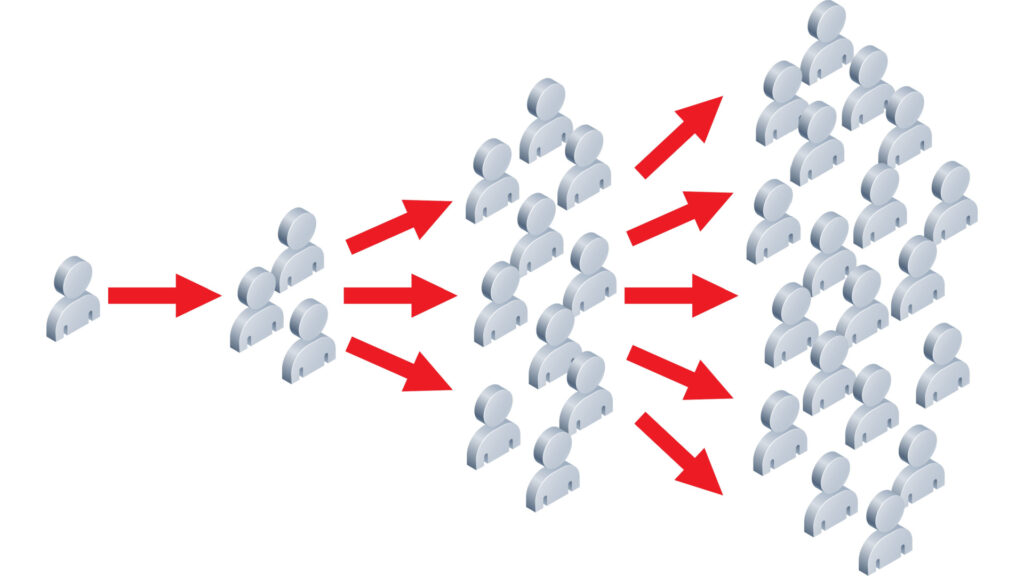
Growth and marketing teams are constantly seeking new strategies to propel their growth and maximize their user base. One such strategy that has gained immense popularity is the concept of a viral acquisition growth loop. With its ability to organically attract and engage users, a viral acquisition growth loop has become the holy grail for growth-focused marketers. In this article, we will delve deep into the intricacies of creating a successful viral acquisition growth loop and explore various incentivized and non-incentivized approaches to achieve this goal.
What Is Viral Growth Loop?

Before we dive into the techniques and strategies, it is crucial to understand the core concept of a viral growth loop. Simply put, a viral growth loop is a marketing strategy designed to utilize the natural tendency of users to share, invite, refer, or collaborate with others. It leverages the power of word-of-mouth, social connections, and virality to propel the acquisition of new users. By creating a self-sustaining loop, businesses can tap into the exponential growth potential.
Imagine this: you stumble upon a captivating video on your favorite social media platform. It’s so entertaining and informative that you can’t help but share it with your friends. You send it to your best friend, who then shares it with their colleagues, and the cycle continues. This is the essence of a viral growth loop – the seamless and continuous sharing of content that leads to a snowball effect of user acquisition.
But how does a viral growth loop actually work? Let’s break it down. First, it starts with an exceptional product or service that grabs the attention of users. Whether it’s a groundbreaking app, a hilarious video, or a thought-provoking article, the content needs to be compelling enough to spark interest and motivate users to share it with others.
Once the content is shared, it reaches a wider audience, exposing more people to the product or service. This increased exposure leads to more users trying out the offering, which in turn generates more sharing. As the cycle repeats, the user base expands exponentially, creating a self-sustaining loop of growth.
One key element of a viral growth loop is the ease of sharing. Platforms that facilitate easy sharing, such as social media networks or messaging apps, play a crucial role in enabling the viral spread of content. By providing seamless sharing options, these platforms remove barriers and encourage users to spread the word effortlessly.
Another important aspect of a viral growth loop is the incentive for users to share. People are more likely to share content if they feel they will gain something from it. This can be in the form of social validation, rewards, or exclusive access to additional features. By incorporating these incentives, businesses can further amplify the viral effect and drive even more organic growth.
It’s important to note that not all products or services are suitable for a viral growth loop. Certain characteristics, such as high user engagement, shareability, and a strong value proposition, are essential for a successful viral marketing strategy. Additionally, understanding the target audience and their motivations is crucial in crafting content that resonates and compels them to share.
Incentivized Growth Loops

One widely used approach to create a viral acquisition growth loop is by incentivizing users to share and promote the product. This can be achieved through a variety of incentives that cater to different user preferences. Let’s explore some of the most effective options:
Incentive Option 1: Money
When it comes to incentivizing users, one of the most powerful options is to offer monetary rewards or discounts for referrals. By tapping into the inherent motivation of users to earn or save money, businesses can create a strong incentive for users to share the product with their network. Not only does this expand the user base, but it also helps to establish a sense of trust and credibility for the product.
Incentive Option 2: Features
Another approach to incentivize users is by providing exclusive features or early access to those who refer others. This not only motivates users to share the product but also creates a sense of exclusivity and enhances the value proposition for potential users. By offering unique benefits to those who actively promote the product, businesses can foster a community of brand advocates who are passionate about spreading the word.
Incentive Option 3: Content
For businesses that heavily rely on content marketing, providing high-quality content or premium subscriptions as incentives can be a game-changer. By offering valuable and engaging content to users who refer others, businesses can encourage users to share the content with their network. This not only helps in building a loyal community of users but also establishes the brand as a trusted source of information and expertise.
Additional Incentive Options
In addition to these options, businesses can also consider other incentives such as loyalty points, free trials, or access to exclusive events. The key is to understand the target audience and tailor the incentives to their preferences and motivations. By continuously experimenting and optimizing the incentives, businesses can create a growth loop that drives sustainable and scalable user acquisition.
Non-Incentivized Viral Growth Loops

While incentivizing users can be highly effective, it is not the only way to create a viral acquisition growth loop. Non-incentivized approaches, although more challenging, can also yield remarkable results.
Non-incentivized viral growth loops are strategies that focus on organic and natural user behavior to drive growth and user acquisition. These approaches rely on creating a product or service that naturally attracts user attention and prompts them to share it with others.
Non-Incentivized Product Exposure Growth Loops
This approach focuses on creating an experience that exposes new users to the product organically as existing customers use the product. It typically involves a visual component that a new users sees or experiences.
For example, when someone gives blood, they often receive a sticker that says, “I save lives, I gave blood.” A percentage of people that see that sticker think “I want to save lives too” and they give blood.
Reforge provides some great examples of companies that use non-incentivized exposure growth loops such as Uber (neon car signs), Lime (bright lime green scooters), and Survey Monkey (signup CTA on survey respondent pages)
Non-incentivized product exposure growth loops require a deep understanding of user psychology and behavior. By tapping into users’ natural inclination to share interesting and valuable experiences, companies can create a self-sustaining growth loop.
Non-Incentivized Product Usage Growth Loops
Similar to the previous approach, this strategy relies on creating a product or service that is so valuable and indispensable to users that they naturally spread the word by inviting, sharing, referring, or collaborating within the product itself.
One classic example of a non-incentivized product usage growth loop is seen in design collaboration software like Figma or Canva. Users create designs and share with their friends and colleagues. A percentage of these users create an account to access and collaborate on the project. They key here is to seamless integrate the sharing, collaboration, or inviting functionality into the core features and value proposition of the product.
Non-incentivized product usage growth loops require a deep understanding of user needs and desires. By delivering exceptional value and becoming an indispensable part of users’ lives, companies can harness the power of product usage growth loops.
Tracking and Analyzing Performance of a Viral Acquisition Growth Loop

Implementing a viral acquisition growth loop is only the first step. To ensure its effectiveness and optimize its performance, businesses must diligently track and analyze various metrics. This includes monitoring user engagement, referral rates, conversion rates, and overall growth patterns. By leveraging data-driven insights, businesses can identify bottlenecks, iterate on their strategies, and enhance the viral growth loop.
When it comes to tracking user engagement, businesses can use a variety of tools and techniques. One common approach is to implement event tracking with Google Analytics, which allows them to monitor specific actions taken by users on their website or app. This could include tracking the number of clicks on a call-to-action button, the amount of time spent on a particular page, or the completion of a form. By analyzing this data, businesses can gain valuable insights into how users are interacting with their viral acquisition growth loop.
In addition to tracking user engagement, it’s also crucial to monitor referral rates. Referrals play a significant role in the success of a viral acquisition growth loop, as they are the primary source of new users. By tracking the number of referrals generated and analyzing the channels through which they are coming, businesses can determine which strategies are most effective in driving referrals. This could include incentivizing users to refer their friends, implementing social sharing buttons, or partnering with influencers to promote their product or service.
Conversion rates are another important metric to track and analyze. A high conversion rate indicates that the viral acquisition growth loop is effectively turning visitors into customers or users. By monitoring conversion rates at different stages of the loop, businesses can identify any areas where users are dropping off or experiencing friction. This could be due to a confusing user interface, a lengthy sign-up process, or a lack of clear value proposition. By addressing these issues, businesses can improve their conversion rates and maximize the impact of their viral growth loop.
Lastly, businesses should analyze the overall growth patterns of their viral acquisition growth loop. This involves tracking the number of new users acquired over time and identifying any trends or patterns. For example, businesses may notice that their growth rate increases significantly after implementing a new marketing campaign or releasing a new feature. By understanding these growth patterns, businesses can make data-driven decisions on how to allocate resources and scale their viral acquisition efforts.
The process of measuring the ROI and performance of your growth loop requires a much more detailed explanation into measuring the growth multiplier, also known as the viral coefficient. This article does not go into detail on that process, but feel free to reach out for more information.
Optimizing Your Conversion Funnel for a Viral Acquisition Growth Loop

While a viral acquisition growth loop focuses on attracting new users, it is equally important to ensure that the conversion funnel is optimized. This involves creating a seamless user experience, implementing persuasive call-to-actions, and streamlining the onboarding process. By reducing friction and maximizing the conversion rate, businesses can capitalize on the influx of new users and foster sustainable growth.
One key aspect of optimizing the conversion funnel is to create a seamless user experience. This can be achieved by designing a user interface that is intuitive and easy to navigate. By minimizing the number of steps required to complete a conversion, businesses can reduce the likelihood of users dropping off and increase the chances of them converting.
Another important element of optimizing the conversion funnel is the implementation of persuasive call-to-actions. These are strategically placed buttons or links that encourage users to take a specific action, such as signing up for a newsletter or making a purchase. By using compelling language and visually appealing design, businesses can increase the conversion rate and drive more users through the funnel.
In addition to creating a seamless user experience and implementing persuasive call-to-actions, streamlining the onboarding process is also crucial. This involves making the initial user experience as smooth and frictionless as possible. By providing clear instructions, eliminating unnecessary steps, and offering helpful resources, businesses can ensure that new users have a positive first impression and are more likely to convert.
Furthermore, businesses can optimize the conversion funnel by analyzing performance metrics. By tracking key metrics such as conversion rate, bounce rate, and average time on page, businesses can identify areas of improvement and make data-driven decisions. This allows them to continuously refine their conversion funnel and maximize the effectiveness of their viral acquisition growth loop.
Additionally, it is important to note that the optimization process is not a one-time effort. As user behaviors and preferences change over time, businesses must continuously monitor and adapt their conversion funnels to stay ahead of the competition. By staying proactive and staying up-to-date with the latest industry trends, businesses can maintain a competitive edge and continue to drive growth through their viral acquisition growth loop.
Moreover, businesses can also explore non-incentivized approaches to optimize their conversion funnels. While incentives can be effective in attracting new users, they may not always result in long-term engagement and conversion. By focusing on providing value and building trust with users, businesses can create a sustainable conversion funnel that generates consistent results.
Lastly, it is worth mentioning that optimizing the conversion funnel is not solely about increasing the number of conversions. It is equally important to focus on the quality of conversions. By attracting users who are genuinely interested in the product or service being offered, businesses can increase customer satisfaction and retention rates. This can lead to higher customer lifetime value and ultimately contribute to the overall success of the viral acquisition growth loop.